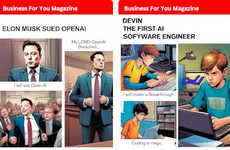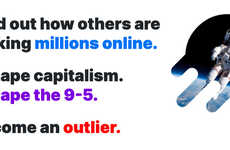
Shelby Lee Walsh — November 6, 2009 — About
References: exploitingchaos & fastcompany
How do you prosper during times of financial crisis? According to Fast Company, you have to “hold to core values, and then become incredibly creative, nimble, resourceful, responsive and efficient.” One of the leading books that is attempting to make sense of all the noise is Jeremy Gutsche’s book EXPLOITING CHAOS: 150 Ways to Spark Innovation in Times of Change, which Fast Company recently featured.
Achieve insight on the economic crisis and how to keep your business afloat by having a look at the full article below.
BY DAVID HEITMAN
Whew! The recession is over. Well, that’s a relief
Or so said the Commerce Department. The 3.5% GDP growth in Q3 proves it. Right?
The announcement has been greeted with understandable and almost universal skepticism. It obviously comes as small comfort to the nearly one in ten unemployed Americans and their millions of underemployed brethren.
The problem is that the upheaval of the last year has shaken things up more than we can possibly foresee. The government steroid…er…I mean…stimulus…programs couldn’t help but stem the tide of economic decline temporarily.
I’ve done enough home improvement projects using duct tape to know that temporary fixes work…well sort of.
To call what we’re entering uncharted waters would be an understatement. I know this is true when I see the names of some of the leading new business books: There’s The Chaos Scenario by Bob Garfield (actually a great read) and Exploiting Chaos: 150 Ways to Spark Innovation During Times of Change.
The point is that what has happened in the last year and a half has been more than “disruptive.” That buzzword of the early 2000s sounds somehow quaint today in light of the current situation.
I’m no economist, but at least some of the economic news I read, and more importantly the conversations I’ve had with business owners and CEOs, suggest one thing: That somewhere along the way roughly 25 – 30% of revenue, employee count and most other business measurables have been eliminated.
Not just “disrupted” but permanently destroyed. Disappeared.
It’s as though some cosmic macroeconomic samurai sword swept down and lopped off the top third of the economy.
Some companies are successfully navigating these dangerous waters, and thankfully, nearly all of our clients are among them. We’ve partnered with them to launch new brands and sub-brands, new products and services, while holding true to their core values, service commitments and brands.
That seems to be the formula. Hold to core values, and then become incredibly creative, nimble, resourceful, responsive and efficient.
Oh, and did I mention fast?
Achieve insight on the economic crisis and how to keep your business afloat by having a look at the full article below.
Not Disruptive…Destructive
BY DAVID HEITMAN
Whew! The recession is over. Well, that’s a relief
Or so said the Commerce Department. The 3.5% GDP growth in Q3 proves it. Right?
The announcement has been greeted with understandable and almost universal skepticism. It obviously comes as small comfort to the nearly one in ten unemployed Americans and their millions of underemployed brethren.
The problem is that the upheaval of the last year has shaken things up more than we can possibly foresee. The government steroid…er…I mean…stimulus…programs couldn’t help but stem the tide of economic decline temporarily.
I’ve done enough home improvement projects using duct tape to know that temporary fixes work…well sort of.
To call what we’re entering uncharted waters would be an understatement. I know this is true when I see the names of some of the leading new business books: There’s The Chaos Scenario by Bob Garfield (actually a great read) and Exploiting Chaos: 150 Ways to Spark Innovation During Times of Change.
The point is that what has happened in the last year and a half has been more than “disruptive.” That buzzword of the early 2000s sounds somehow quaint today in light of the current situation.
I’m no economist, but at least some of the economic news I read, and more importantly the conversations I’ve had with business owners and CEOs, suggest one thing: That somewhere along the way roughly 25 – 30% of revenue, employee count and most other business measurables have been eliminated.
Not just “disrupted” but permanently destroyed. Disappeared.
It’s as though some cosmic macroeconomic samurai sword swept down and lopped off the top third of the economy.
Some companies are successfully navigating these dangerous waters, and thankfully, nearly all of our clients are among them. We’ve partnered with them to launch new brands and sub-brands, new products and services, while holding true to their core values, service commitments and brands.
That seems to be the formula. Hold to core values, and then become incredibly creative, nimble, resourceful, responsive and efficient.
Oh, and did I mention fast?
Trend Themes
1. Core Values - Disruptive innovation opportunities lie in aligning business strategies with core values to navigate and thrive in times of change.
2. Creative Adaptation - Disruptive innovation opportunities arise from embracing creative, nimble, resourceful, responsive, and efficient approaches to address market disruptions.
3. Future-proofing - Disruptive innovation opportunities are found in developing strategies and solutions that prepare businesses to withstand and adapt to unpredictable economic upheavals.
Industry Implications
1. Business Consulting - Disruptive innovation opportunities exist in the business consulting industry to assist companies in aligning core values, embracing creativity, and adapting to market disruptions.
2. Brand Strategy and Marketing - Disruptive innovation opportunities can be explored in the brand strategy and marketing industry to help businesses thrive by aligning core values, fostering creative adaptation, and future-proofing their brands.
3. Entrepreneurship - Disruptive innovation opportunities can be explored by entrepreneurs who are willing to navigate times of change by holding true to core values, embracing creativity, and adaptability.
3
Score
Popularity
Activity
Freshness
























